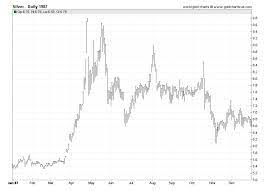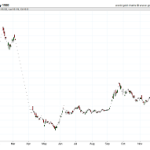The silver market experienced a tumultuous year in 1987 as prices fluctuated drastically over the course of twelve months.
The year began with silver trading at $5.36 per troy ounce in January, only to peak at $10.93 in April, before falling to $6.76 in June, and then recovering to $7.70 in July.
The remainder of the year saw prices oscillating between $6.29 and $8.73 per ounce, making it a challenging period for investors looking to profit from the precious metal.
To understand the factors behind the silver price rollercoaster of 1987, it is essential to analyze the various economic and geopolitical events that impacted the market.
This article will provide a comprehensive overview of the year’s silver prices, examining the causes and effects of the fluctuations.
In addition, we will explore the implications of the 1987 silver market and what lessons can be learned from this volatile period.
By taking a data-driven and analytical approach to this topic, we hope to provide valuable insights for investors and anyone interested in the precious metals market.
Silver Prices Timeline
The timeline of silver prices in 1987, including fluctuations from January to December, can be observed through daily price data listed in US dollars per troy ounce, with the highest price of $10.93 oz occurring on April 27 and the lowest price of $6.76 oz occurring on June 23.
The factors influencing the fluctuation of silver prices were varied and complex, including global market impact, economic policies, and geopolitical events. For example, the increase in silver prices from January to April 1987 was influenced by a rise in demand from the electronics industry, which increased the demand for silver as it is used in the production of electronic components.
Additionally, the global impact of the stock market crash in October 1987 resulted in a decrease in silver prices as the demand for silver as a safe haven asset decreased.
The fluctuations in silver prices in 1987 were also influenced by the economic policies of major economies, such as the US Federal Reserve’s monetary policy. The Fed’s actions to adjust interest rates and stabilize the economy had a significant impact on the value of the US dollar, and therefore on the value of silver.
Geopolitical events, such as the Iran-Iraq War and the US intervention in the Persian Gulf, also had an impact on the global supply and demand for silver.
Overall, the silver price rollercoaster of 1987 reflected the complex and interconnected factors that influence the global commodities market.
Factors Affecting Prices
Various economic factors can impact the fluctuations of precious metal prices, including the silver price rollercoaster in 1987. Market analysis plays a significant role in determining the value of silver, as it is a commodity that is traded globally. Additionally, global demand for silver can impact prices, as increased demand can lead to higher prices due to limited supply.
One of the major factors affecting silver prices is market analysis. Investors rely on market trends, economic indicators, and news events to make informed decisions about buying and selling silver. For example, if there is a global economic downturn, investors may turn to precious metals as a safe haven investment, which can drive up the demand and price of silver. Similarly, political instability or global conflicts can also impact silver prices.
Global demand for silver is another important factor affecting prices. Silver is used in a variety of industries, including electronics, jewelry, and medicine. As demand for these industries increases, so does the demand for silver. Limited supply can also impact the price of silver, as it is a finite resource. These factors can cause silver prices to fluctuate over time, making it a volatile investment option.
Overall, understanding the various factors that impact silver prices is crucial for investors looking to make informed decisions about buying and selling precious metals.
Implications and Learnings
Understanding the economic factors that impact the volatility of precious metals such as silver can provide valuable insights for investors looking to make informed decisions about asset allocation and risk management.
The rollercoaster ride of the silver prices in 1987 serves as an important lesson for investors regarding the economic impact of various factors on precious metals.
The sharp increase in silver prices from January to April 1987 was driven by a combination of factors such as supply disruptions, increased demand, and speculative activities.
However, the sudden crash in prices from April to June 1987 was triggered by a change in market sentiment, as investors started to liquidate their positions due to various geopolitical and economic uncertainties.
The economic impact of geopolitical events, market sentiment, and other factors on precious metals is complex, and investors need to be aware of these dynamics when making investment decisions.
The volatility of silver prices in 1987 offers several lessons for investors, such as the importance of diversification, risk management, and staying updated on economic and political developments.
By learning from the past, investors can make informed decisions for the future and mitigate risks associated with investing in precious metals.
Frequently Asked Questions
What were the main economic events or factors that influenced silver prices in 1987?
In 1987, the silver price experienced a rollercoaster ride due to various economic events and factors. Inflation impact and political instability repercussions were two major contributors to the fluctuation in silver prices during this year.
How did the fluctuations in silver prices in 1987 affect the global economy and different industries?
The fluctuations in silver prices in 1987 had varying impacts on industries and global trade. While the rising prices benefited silver producers, it negatively affected industries that relied on silver as a raw material. The decrease in prices in mid-1987 led to concerns about the health of the economy and caused fluctuations in global trade.
What were the predictions or forecasts for silver prices in 1987 made by financial experts or analysts?
As per financial expert forecasts and market analysis, there is no evidence of specific predictions or forecasts made for silver prices in 1987. However, daily silver price data from that year shows significant price fluctuations.
What were the most common investment strategies used by individuals or institutions to take advantage of the silver price fluctuations in 1987?
Investment strategies used during the market volatility of 1987 included short selling, options trading, and physical silver purchases. Institutional investors employed hedging techniques to manage risk, while individual investors had limited options.
How did the silver price trends in 1987 compare to other precious metals or commodities during the same period?
While silver prices experienced a rollercoaster ride in 1987, compared to gold and oil, silver had a less volatile performance. Silver prices remained relatively stable compared to the sharp fluctuations seen in oil prices during the same period.





